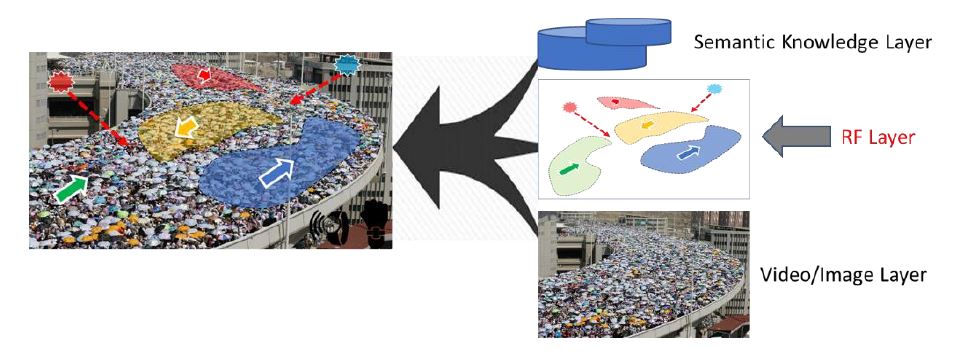Intelligent Mobility Characterization & Analytics for Crowd Management
Abdoh Jabbari, Khalid J Almalki, Baek-Young Choi and Sejun Song
Due to the unprecedented scale and speed of urbanization, cities are facing the daunting task of accommodating the urban dynamics. One of the critical service requirements of future cities is the safety management for citizens and communities [1]. During large scale entertainment events (e.g., sport, music, etc.), religious gatherings or political rallies, however, it is extremely challenging yet especially essential to do crowd safety management. For a large moving crowd, a minor accident may create a panic for the people to start a stampede, and during emergency incidents, speedy evacuation is critical. Effective and efficient crowd monitoring and guidance would reduce or prevent participants’ frustrations, injuries, and casualties.
Although many smart video surveillance tools, inspired by the recent advances in Artificial Intelligence (AI) technology and Machine Learning (ML) algorithms, enable object detection and identification [2] [3], video surveillance alone cannot identify and predict particular crowd status. Video-based approach alone does not scale well, thus cannot provide an appropriate mobile crowd safety management in real-time. For example, in Mecca, Saudi Arabia, although there is 5,000 smart video surveillance cameras installed for monitoring the Hajj crowd [4], the accident caused by the mobile crowd results in many human casualties.
In our recent research work [5], we proposed an intelligent mobility characterization and analytics framework that enhances safety management for mobile crowd events by predicting and preventing potential disasters through real-time Bluetooth Low Energy (BLE) signal characterization and analytics. The framework implementation consists of three main components including a BLE transmitter tag, a BLE signal scanner, and an analytic server. Among the crowd mobility characteristics, it identifies the crowd density, the object group location, and the flow direction and speed by analyzing BLE beacon counts, the Radio Strength Signals Received (RSSI) power, and its variation pattern. Addressing the scalability and capability issues of the smart video surveillance by tightly integrating BLE signal analytics (Fig. 1), our work translates the signals into group semantics to track the crowd status and predict any potential accidents and disasters.
Figure 1. Intelligent Mobility Characterization and Analytics Framework
We have conducted various practical mobile crowd experiments in both indoor and outdoor environments under different crowd movement scenarios. The results show that our approach can effectively detect the direction, the location, the speed, and the density of the mobile crowd in real-time. It demonstrates the feasibility of using the framework and sheds lights on future crowd safety management systems.
References
[1]. E.N. Service, “Requirements and future of Smart Cities,” https://www.expresscomputer.in/columns/464icts-and-smart-cities/2434/, 2014.
[2]. S. Bek and E. Monari, "The crowd congestion level - A new measure for risk assessment in video-based crowd monitoring," IEEE Global Conference on Signal and Information Processing (GlobalSIP), Washington, DC, 2016.
[3]. S. Kojima, A. Uchiyama, M. Shirakawa, A. Hiromori, H. Yamaguchi and T. Higashino, "Crowd and event detection by fusion of camera images and micro blogs," IEEE International Conference on Pervasive Computing and Communications Workshops (PerCom Workshops), Kona, HI, 2017, pp. 213-218.
[4]. C. Charlton, "Inside Mecca's Matrix", Mail Online, 2015. [Online]. Available: http://www.dailymail.co.uk/news/article-3242095/Hi-tech-hajj-Officers-monitor-live-feed-screens-monitoring-one-world-s-biggest-crowds-100-000-security-men-gear-Mecca-arrival-3million-pilgrims.html.
[5]. Abdoh Jabbari, Khalid J Almalki, Baek-Young Choi, and Sejun Song. CROMO: Enhancing Crowd Mobility Characterization through Real-time Radio Frequency Data Analytics”, IEEE International Smart Cities Conference (ISC2), Kansas City, USA 2018.
Contributors
 |
Abdoh Jabbari is a Ph.D. student at the University of Missouri-Kansas City (UMKC). Also, he is a faculty member of Jazan University, Saudi Arabia. He received his BS in Network Engineering from the Johnson and Wales University, RI, USA and his MS in Computer Information and Network Security from the DePaul University, Chicago, IL, USA. His research of interest is IoT, Wireless Sensors, and Crowd Sciences. |
 |
Khalid J Almalki is a Ph.D. student at the University of Missouri – Kansas City (UMKC). He received the master’s degree in computer science from the University of Missouri – Kansas City, in 2018. He received the B.S. degree in Computer Networking from Jazan University, Saudi Arabia, in 2014. His research interests in Smart Cities Technologies and Artificial Intelligence. |
 |
Baek-Young Choi is an Associate Professor in the Department of Computer Science and Electrical Engineering at the University of Missouri-Kansas City. She received her PhD in Computer Science and Engineering from the University of Minnesota, Twin Cities. She has been a Fellow of the US Air Force Research Laboratory. Visiting Faculty Research Program (AFRL-VFRP), and Korea Telecom-Advance Institute of Technology (KT-AIT). Her research interests lie in the broad area of algorithm and system development for diverse types of networks, especially in software-defined networking, cloud computing and internet-of-things. |
 |
Sejun Song is an Associate Professor in the Department of Computer Science Electrical Engineering at University of Missouri-Kansas City. His research team conduct research in the areas of trustworthy information and computing systems and software including resilient network and system management, software-defined networks, cloud computing auditability, mobile cloud computing, security, high availability, data storage, and embedded systems. He received his MS and PhD degrees in Computer Science and Engineering from the University of Minnesota, Twin Cities, respectively. |
Past Issues
To view archived articles, and issues, which deliver rich insight into the forces shaping the future of the smart cities. Older eNewsletter can be found here. To download full issues, visit the publications section of the IEEE Smart Cities Resource Center.


